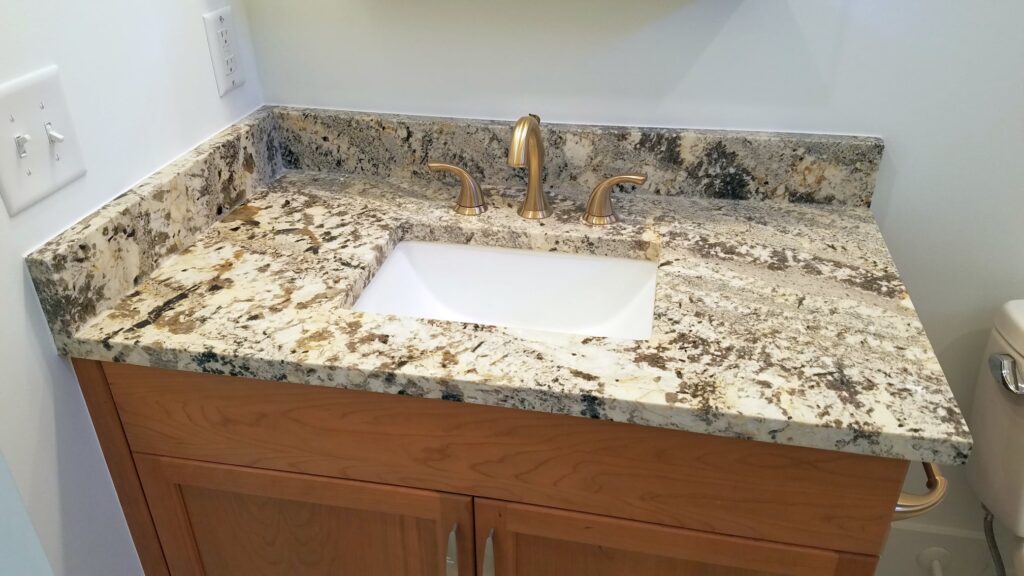
By the time a granite countertop makes its way into your home, the stone has already passed through hundreds of pairs of hands. Learning how granite countertops are made will help you appreciate the priceless nature of this beautiful stone.
Quarrying the Stone
Granite is a natural stone, and veins of it can be found all over the world. The color and pattern of granite vary based on the region it comes from. No two veins of granite are alike, making this stone truly priceless and irreplaceable.
Once a stone company finds a granite vein they like, the land is purchased and turned into a quarry. A combination of laser cutters and explosives are then used to remove large blocks of granite in a controlled pattern. These blocks are then laid on a bed of sand and transported to a manufacturing facility.
Cutting the Slabs
Stone manufacturers turn large blocks of granite—and other types of natural stone—into standardized slabs. Thicknesses and lengths are determined based on what the stone will be used to make. Although every manufacturer is different, most slabs are cut with either laser or water-jet technology. Finally, one side of the slab is polished until the beautiful pattern of the granite is revealed.
Finished slabs are then sent to stone distributors located around the world. As a customer, you can tour your local distribution facility to select the slab that will become your new countertop.

Templating the Kitchen
From a fabricator’s point of view, the counter creation process starts in your kitchen. Once you’ve discussed your ideas and settled on a design, a member of the fabrication team will measure your current countertops and create a template for the new countertop. It’s important to make sure that your kitchen is finished before the template is made. If you change the layout afterward, your new countertops won’t fit.
Around the time the template is made, your fabrication team will also discuss your style preferences. Expect to review various edging choices, look at a few material samples, and talk about how your countertops will interact with other parts of your kitchen. You will also get the chance to visit a stone distributor and select your own piece of stone.
Fabricating the Countertop
After you select a granite slab, the distributor will put it on hold until a member of the fabrication team can pick it up. This ensures that your countertops are always made with your exact chosen piece of stone.
Using the template as a guide, the natural stone fabrication team will cut the slab into various pieces. Each cut is made with the pattern of the granite in mind; if there’s a particularly beautiful part of the stone, you can expect to see it front and center.
Your countertop won’t be finished until the edges are beveled and polished. Nearly all cutting and polishing is done with machine assistance, but your fabricators may still use traditional hand-based methods for the final touches. Masonry is a type of art, and every good fabricator takes pride in their craft.
Completing the Project
The final step is to install the new countertops in your kitchen. On the scheduled installation day, the fabrication team will arrive with your new granite countertops. Unless you have a small kitchen, expect to see multiple pieces of granite brought in to be installed.
The fabrication team will remove your old countertops and make sure the new countertops fit correctly. Most fabricators can make needed adjustments on-site, which means you’ll never have to schedule a new installation day. Once everything fits, the fabricators will fix the granite in place and seal it to protect the stone.
Skilled fabricators can make a granite countertop in a shockingly short amount of time, but that doesn’t mean the process is simple. From quarrying to cutting to installation, plenty of hard work and honest effort goes into making your natural stone countertops shine.
Conclusion
The process of how granite countertops are made starts from commencing with the initial quarrying, as granite emerges from the depths of the earth’s core, the subsequent metamorphosis occurs in the hands of skilled artisans who meticulously shape and refine the raw stone into stunning slabs. The culmination of this lies in the installation that seamlessly integrates these magnificent surfaces into your kitchen. The evolution from unprocessed minerals to the resplendent allure of countertops epitomizes the essence of how granite is made – a chronicle of innovation that graces your living spaces.
